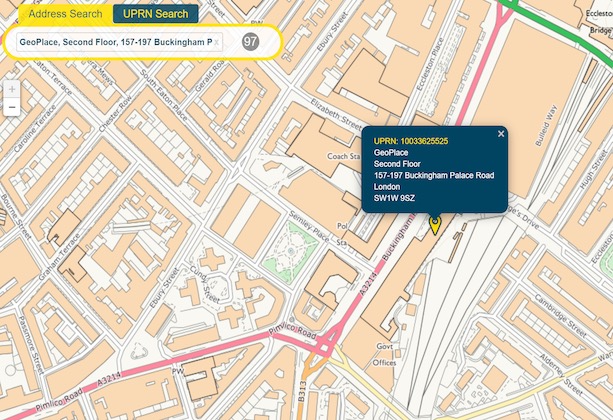
Last June, the Open Standards Board provisionally selected two geographical identifiers for use in government - Unique Property Reference Numbers (UPRNs) and Unique Street Reference Numbers (USRNs). Today the Geospatial Commission announced that UPRN and USRN data will be openly accessible from July onwards.
This means we’ll be able to promote these standards and add them to the list of mandatory open standards for government. Here's how GeoPlace and GDS worked together to go through the open standards process, enabling the board to mandate the use of UPRNs and USRNs. GeoPlace is a Limited Liability Partnership jointly owned by the Local Government Association and Ordnance Survey.
Location registers for the whole country
The UPRN is a unique identifier for every location that can have an address in the UK. Unique numbers are allocated to every single property, including houses and offices. Other objects that you might not think of as needing an address can also have numbers, like bus shelters or lamp posts. The USRN also provides unique identifiers, but for every street in the UK.
Together these identifiers provide a stable and accurate way of referencing properties and streets. This means that any organisation using them can match and exchange records containing location data between different systems. This in turn allows public sector organisations to streamline services, increase the interoperability of technology and improve the quality of the data they hold.
Local authorities, utility companies and emergency services already use these identifiers. For example, systems that use the MAIT standard for sharing emergency incident data between agencies rely on UPRNs to accurately identify properties and get help to where it is needed. But the opening up of the identifiers paves the way for much greater use both inside and outside government.
A central source for UK addresses
UPRNs and USRNs are centrally managed by GeoPlace. They provide every local authority with a range of UPRNs and UPSNs, from which they assign numbers to properties and streets.

A UPRN is a number that is unique to a property. This makes UPRNs different from and more specific than postcodes, which might not distinguish between different properties within a single building (such as flats) and often cover multiple different buildings. USRNs are unique 8 digit numbers that are assigned to streets, roads, footpaths or public rights of way. Together these numbers allow users to pinpoint properties and their locations to a high degree of accuracy and dependability. They will soon be freely available as open data for the first time.
Increasing adoption through the Open Standards Board
GeoPlace believes the use of UPRNs and USRNs throughout the public sector will improve the efficiency and integration of services. Some areas of government already benefit from this dependable and consistent way of identifying properties and streets. For citizens, wider adoption can also help to improve areas such as education, housing, transport and security.
Approving UPRN and USRN as mandatory open standards for use within government will help to accelerate this adoption. GeoPlace believes this is a huge step forward in recognising the power of commonly referenced property and street data.
Revisiting a previous challenge
The Open Standards Board had looked at the issue of unique identifiers for addresses before. In 2015, GDS used their open standards process to suggest an open identifier for properties. It noted that UPRNs were considered the canonical source for defining discrete pieces of land or buildings in England and Wales. But at the time, the board decided that the UPRN should not be adopted as an open standard because of licensing restrictions.
By 2019 GeoPlace was working with the Geospatial Commission to make the URPN and USRN registers open data. This work took place alongside the development of the Public Sector Geospatial Agreement (PSGA), a new 10-year arrangement with the government to transform public sector use of location data.
Last January, GeoPlace suggested a new challenge on the open standards GitHub page for UPRN and USRN. The open standards team put the new challenge through the proposal and solution stages, and it was accepted with conditions by the board in June 2019. When the data is made open, these conditions will have been met and GDS will be able to publish UPRN and USRN on its list of mandated standards.
Next steps for the new standards
These identifiers become more effective the more systems use them, and opening up the data removes barriers to adopting them. Public sector service designers and architects should start to incorporate the identifiers into relevant data sets, and prepare to publish them where possible. Vendors should plan to integrate the identifiers into their technology. Data analysts and scientists will be able to use UPRNs and USRN to join datasets up in new ways to gain new perspectives.
If you work in the public sector and use property or location data, get in touch with GeoPlace to see how you can start to use them.
Finding new open standards
If you know of a public sector challenge that might have a standards-based solution or even a standard that might meet a known user need, you can propose it. Anyone can take part by:
- Visiting the Open Standards team's GitHub issues page
- Suggesting a standard or specification that meets a user need, or suggesting a challenge where standards might improve outcomes
For more information on open standards in government, please get in touch by emailing us at openstandards@digital.cabinet-office.gov.uk.

3 comments
Comment by George Lund posted on
This is fantastic... But is the announcement a bit premature?-- because the "get in touch with us" link takes you to a quasi-commercial (?) entity's email address (who is "us" then, seeing as this is on the GDS blog?!) and their web site still has a paywall before you can see any technical detail rather than just marketing (presumably only until July?). A link to some technical detail about how these codes work would be really great, thanks.
Comment by Lawrence posted on
Thank you, George. This announcement was prompted by the new Public Sector Geospatial Agreement ahead of the identifiers with associated geometry being released openly in July.
There is some more information about access to the data from Ordnance Survey in this article -
https://www.ordnancesurvey.co.uk/business-government/public-sector-geospatial-agreement
More detail should be forthcoming from the agencies involved in the coming months.
Comment by Graham Galloway posted on
My district council has a casual approach to property numbering. I live in a semi-detached block of flats. This building has never been issued with a street number although it has flat numbers. Also importantly the two buildings have only one UPRN and that was inherited from a detached house which was demolished. The council is responsible for that.
The database is an excellent idea but to call it definitive is stretching it a bit.